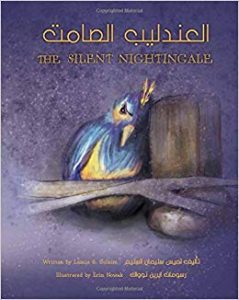Fresh Perspectives in Indie Picture Books: The Silent Nightingale
Although I didn’t sign up for the Winter Conference of the Society of Children’s Book Writers and Illustrators last year in New York City, I made my way to the Midtown Manhattan conference hotel one evening for a Marginalized Writers’ Meet-Up. The first of its kind at SCBWI, the meet-up was organized by Puerto Rican author and activist Adria Quinones and drew almost 100 writers, editors, and agents to a room best suited for a crowd half that size. Since then Adria has scheduled monthly meet-ups of SCBWI members and other children’s writers and illustrators in the New York City metropolitan area under the hashtag #dialogs. At these meetings, IPOC, LGBTQ+, and disabled children’s book creators share news, information, and advice.
At the last #dialogs, I had the pleasure of meeting Saudi Arabian-born author Dr. Lamis S. Solaim, who recently moved from New York City from Syracuse and brought with her the picture book The Silent Nightingale, which she self-published under the imprint Mascot Books. She worked with Syracuse-based illustrator Erin Nowak to create a gorgeous book for children, ages 3-7 and their families. I talked her into giving me a copy of her book and right away knew I had to review it for The Pirate Tree, and just in time for the holiday giving season. Here is my review, slightly edited:
 Solaim’s bilingual (English-Arabic) picture book features a large Middle Eastern family visiting their grandparents’ home. The oldest boys find a nightingale, the next-oldest children build an elaborate cage and sing for it, and the youngest ones bring treats and do acrobatic tricks to urge the bird to make a sound. Still, the beautiful bird remains silent — and downcast. But after the grandfather sings the youngest child a popular song by a nineteenth century Iraqi poet about the importance of freedom for the creation of beauty, the children realize that the bird should be set free to sing in the wild. Nowak’s colorful, detailed, and evocative illustrations convey both the children’s emotions and the overall mood of the book.
Solaim’s bilingual (English-Arabic) picture book features a large Middle Eastern family visiting their grandparents’ home. The oldest boys find a nightingale, the next-oldest children build an elaborate cage and sing for it, and the youngest ones bring treats and do acrobatic tricks to urge the bird to make a sound. Still, the beautiful bird remains silent — and downcast. But after the grandfather sings the youngest child a popular song by a nineteenth century Iraqi poet about the importance of freedom for the creation of beauty, the children realize that the bird should be set free to sing in the wild. Nowak’s colorful, detailed, and evocative illustrations convey both the children’s emotions and the overall mood of the book.
While the story itself is predictable and has been told many times (more an issue for the adult than for a child hearing the picture book for the first time), the Arabic text and the setting within a specific culture differentiates this retelling. The family is large, which breaks the rules for picture books, but is an honest depiction of the lives of many Americans of Middle Eastern heritage, who regularly gather in multigenerational family compounds. Solaim and Nowak immerse readers in this lively, busy environment. The story also ends with an adult character offering a didactic message, this time in the form of a traditional song. Typically in U.S.-published picture books, the individual child is the one who solves the problem. But in other cultures, children defer to adults, and in many of these cultures, particularly in the Middle East and Africa, an elder teaches a lesson by singing a song or telling a story.
Solaim self-published The Silent Nightingale in order to make the edition a bilingual one and to bring forth her realistic portrayal of the Middle Eastern family and the way multiple generations interact with each other and pass on knowledge, traditions, and values. Exiling those books from the U.S. publishing mainstream prevents young readers from learning about diverse cultures, intergenerational relationships, and what it means to grow up in another country or culture. Fortunately, this one is available for readers young and old to appreciate, thanks to an enterprising author who wouldn’t take no for an answer.
As a translator, I encounter similar issues in picture books from other countries, most notably the multigenerational family living together and adult who solves the problem rather than the child protagonist. For the most part, these books are a hard sell and when a publisher picks them up, they’re likely to be adapted. I wish U.S. publishers would be less dogmatic about this “child solves the problem” plot structure, because many children in the U.S. live in multigenerational homes and grow up with different ways of interacting with parents and other elders. Children need to see themselves in books, and they need to see how their lives may connect or parallel the lives of children around the world. There is no one “right” way of raising children or depicting childhood. Though exiled from mainstream publishing, The Silent Nightingale, like the small-press-published picture books that I’ve translated from Portuguese, deserve a wide readership.







This post makes a good point. If we are to remain a multicultural country, and I hope that will be true, then books that depict children experiencing their culture the way they know it are valuable for all readers. Empowering children is not only about showing them solving problems. Showing that elders have wisdom worth listening to is also important.
Thank you, Joyce! I also think that the individualistic, nuclear family in the United States is proving an inadequate model to deal with the various crises our nation faces — inequality, climate change, attacks on unions and other forms of working-class political and economic agency, and police repression in communities of color. People of all generations need to band together, or we will all fail apart.
I am just reading this and very much appreciate your review Lynn. Reading it and the kind comments renewed my commitment to writing children’s books that expand our understanding of childhood, society, and culture.
Lamise
I agree with you, Lyn. The fact that an adult solves the problem can be appropriate.
It’s a valid character arc for the child to learn something new from an adult and to emerge stronger as a result.
Brava to Dr. Solaim for her perseverance, and to you, Lyn, for celebrating her.
Thank you, Sarah! And it was a wonderful coincidence that I met Dr. Solaim at the SCBWI event where she brought her new book.